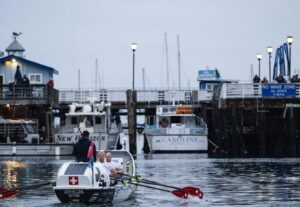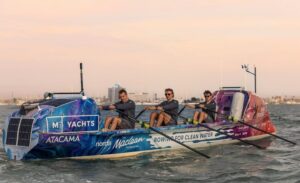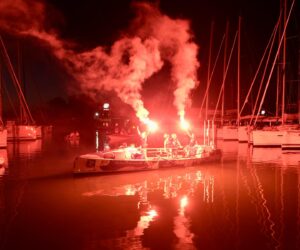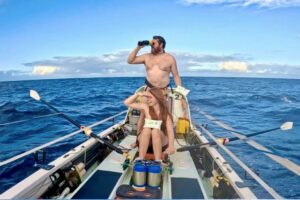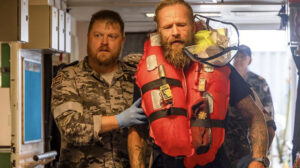Since our last roundup, several crews have been battling their way across both the Pacific and the Atlantic. Although many are nearing the end of their journeys, they face a variety of difficulties. Apart from equipment issues, one rower suddenly lost his sight, and another expedition is grounded indefinitely.
Pacific Ocean
Michelle’s Pacific Row: Michelle Lee is rowing from Ensenada, Mexico to her home in Australia. She has now been on the Pacific Ocean for 224 days. Lee had hoped to complete the 24,000km journey by the end of February, but the weather has slowed her progress substantially.
She has had to cope with five hurricanes and four cyclones. In the middle of February, Cyclone Gabriel kept her locked in her cabin for over a week. Then, when she started rowing again, the winds made progress difficult.
By the end of February, she had had enough. “I really just want the closest piece of land right now,” she said on social media. “At the moment, I’m struggling to achieve any westing at all. It’s freaking hard, I feel like I’m stuck here. It has been 201 days at sea now and yesterday was the first breakdown for me.”
She has pulled herself together and continued. As she chipped away at the remaining distance, her mood changed. She recently celebrated her last full moon of the crossing. “The night is stunning, the sea is calm, I did a toast to the journey and reminisced.”
Lee has 500km remaining.
Atlantic Ocean
Atlantic Dash Challenge: The Atlantic Dash was a small event that took place over the last few months. Just two crews competed, aiming to row from the Canary Islands to Antigua. Throughout the race, both crews have stayed within touching distance.
Atlantic Dragons is a pair made up of Adrian Tyrrell and Daniel Bohin. Cabbies Do Atlantic Row is a trio consisting of Robert Barber, Darren Parr, and Stuart Lockhart. As of February, the trio had gained a slight lead. This was mainly because Atlantic Dragon’s auto helm broke, forcing them to manually steer for the majority of the trip. Cabbies managed to maintain their lead until the end, paddling across the finish line on March 4. Atlantic Dragons crossed one day later.
Other than the steering, the main issue for both crews was the weather. For weeks, they battled rough seas, strong winds, and rain. Then in the final week, the weather became “as flat as a carpet,” according to the Cabbies. Though that might sound better, it was so still that it was like rowing through treacle.
The slow progress and heat forced Bohin to take a break because of exhaustion. Since finishing, both crews have released photos of their weight loss, calling it the “most extreme diet in the world.”
Electrical glitches
Jari Saario: On January 23, Jari Saario started his ambitious two-way crossing of the Atlantic. His plan was to row 8,000km from the Canary Islands to Miami, then wait in the U.S. for a suitable weather window before rowing back across the Atlantic to London.
A week ago he announced that he is having to change his route. He has been struggling with severe electrical issues that he is unable to fix at sea. For safety reasons, he is now rowing to Antigua, which is 1,000km away.
Saario had originally planned to row to Antigua before electing to take on a less popular route to secure funding for the expedition. In the end, he will now have to make his way to Antigua. Once repairs are complete, he will transport the boat to New York, then start across the Atlantic back to London.

Photo: Jari Saario
Two problems: calm seas, high winds
Rame Ocean 2023: With six rowers, this is the largest crew currently on the water. Patrick Favre (FR), Louis Pellet (FR), Dominique Pape (FR), Christophe Huguet (FR), Jerome Caudoux (FR), and Liu Yong (CN) are going from Spain to Guadeloupe. Since setting off on January 30, they have completed 90 percent of their journey.
The team changed their initial route slightly to a more southerly path, hoping for protection from winds and waves. Though it has helped, they have faced another challenge for much of the row: no wind at all. At some points, it has been like rowing on a lake, with nothing to help them move.
To make the most of the calm, the crew has focused on their rowing technique. One benefit: the flat seas have let them do boat maintenance easily.
Then in the first week of March, conditions changed again, and the crew had to contend with both headwinds and crosswinds. Soon after, it was back to the calm, flat water they have seen for much of the journey.
Aurimas Valujavicus: Valujavicus is aiming to row 9,000km from Spain to Miami. He has made good progress, reaching his halfway point in less than two months. As with all Atlantic crossings, he has had to cope with difficult conditions, especially high winds.
A few days ago, Valujavicus hoped that the winds would die down and even turn in his favor. Earlier this week, he confirmed that this had not been the case. It appears that contrary winds will stay for another week.
Despite this, he has remained in good spirits. On March 5, after 70 days at sea, he hit 6,000km traveled.

Photo: Aurimas Valujavicus
Radio silence
Broken Pinkies: This four-man crew completed their 5,800km row from Portugal to French Guyana on March 8. Ralph Tuijn (NL), Jordan Godoy (U.S.), Fionn O’Carroll (IE), and Ciaran Kavanagh (IE) began on January 14.
The crew has made almost no comment on their journey. They had just a simple tracker, and the Ocean Rowing Society confirmed their arrival.
Tujin has previously completed 11 ocean crossings. He put together a crew to try and beat a previous Atlantic crossing time. They were supposed to be a crew of five, but after a dropout, they decided to continue as a foursome.
Simon Howes: Howes began his row from the Canary Islands to St. Lucia on January 16. He has completed 88 percent of a route that only one other rower has done before. As with Broken Pinkies, Howes has not provided a running commentary on his progress.
Howes first attempted to row the Atlantic solo in 2021 as part of the Talisker Whisky Atlantic Challenge. Just days in, he slipped on the deck and injured his elbow, forcing him to pull out. So far, this attempt is looking much more likely to end in success.

Photo: Row for Amy
Row for Amy: Andrew Osbourne has completed 87 percent of his solo row from Gran Canaria to Falmouth Harbour in Antigua. Osbourne set off on January 8. Last week marked his tenth week on the Atlantic Ocean.
Until mid-March, conditions had been very changeable. In early March, a 10-day period of high winds forced him to scramble out of the way of an approaching storm. He then had to deploy his para-anchor for four days, as he waited out the weather.
The winds have finally changed in his favor, and he has 800km to go.
“It feels a little bit like waiting to break up from school for the holidays or what I imagine it feels like waiting to be released from prison. There is still a long way to go, but not when I think about how far I have come. It is now in my grasp and I am determined to get there as fast as I can,” he wrote.
Osbourne is rowing in memory of his daughter Amy. Amy died in her sleep five years ago from an undiagnosed heart condition.
Blindness from seasickness patches
Atlantic Escapade: Andy Hodgson and Rosalind Chasten are rowing from Gran Canaria to Barbados. They set off on February 20 and have covered 59 percent of the route.
Just four days into the row, the pair faced a scary situation: Hodgson could no longer see. His vision had deteriorated to the point where he couldn’t read the charts. They thought it might be similar to snow blindness, perhaps caused by sun glare from the ocean. After some frantic messages to the land team, they discovered that it was a side effect of sea sickness patches. Two days after removing the patches, Hodgson’s sight returned to normal.
The duo has made slow progress with a host of challenges blunting progess. First, there were calm seas, then they had issues with their electronics. An alarm kept going off, making it incredibly hard to sleep. Finally, their GPS system crashed. Unable to track exactly where they were, they had to stop completely to fix the system.

Photo: Atlantic Escapade
Paused expeditions
Tom’s Pacific Row: Tom Robinson is rowing across the Pacific from Lima, Peru to his home country of Australia. On December 10, after 160 days at sea, he completed the first section of his row — 9,260km to Penrhyn, an atoll in the northern Cook Islands.
He has remained on the island for the last three months, waiting out the cyclone season. Now, he is preparing to take to the water again. A cargo ship is bringing the supplies and spare parts he needs for the next leg of the trip.

Photo: Tom Robinson
Ellen Magellan Expeditions: Ellen Falterman began a row around the world on September 3. She started in East Texas and followed the Gulf Intracoastal Waterway to the Florida Panhandle. From there, she crossed the Gulf of Mexico to South Florida.
She paused to spend Christmas with her family, but after a number of bereavements, she has decided not to restart her row.
“Both ship and captain are in a sorry state and it is unsafe for either of us to continue in our current condition. I put my skipper’s stripes back on only briefly to orchestrate an emergency boat rescue operation to secure my vessel. Since then, I have grounded myself until I feel my maritime acumen has returned. I am not selling my boat, and I am not abandoning my expedition,” Falterman wrote.

